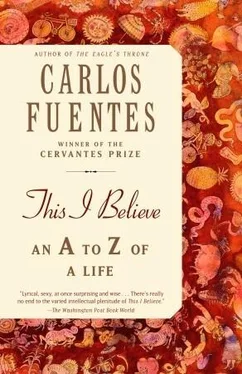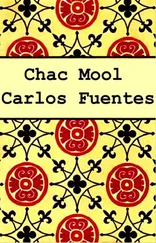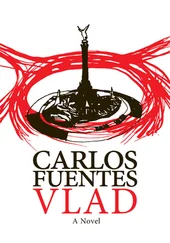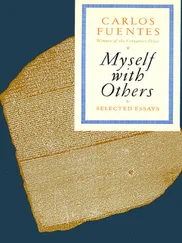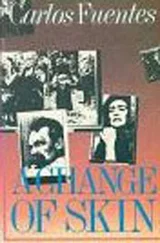The creative personality tells us that the worst sin known to the “I” is that of dispersing ourselves in banal occupations. And to go a bit further, that of working in a field that we dislike. The truly unfortunate “I” is he who fritters away his days in an occupation he detests and that, to make matters worse, he cannot abandon and unconsciously transforms into habit and eventually, inevitability. This category goes from the young restaurant waiter who takes no pains to hide the dissatisfaction he feels with his occupation, to the veteran waiter, who has resigned himself to the notion that serving customers is his destiny. In the middle of this category we find the happy waiter, proud of the service he provides, capable of attaching value and meaning to the fortune— not the misfortune — of contributing to the well-being of the world. The curmudgeon and the defeated soul generally find themselves in the Anglo-Saxon world, a world of bitter displacements and visible dissatisfaction. The individual who is proud of his work because he knows that all work is a worthy and creative pursuit is generally found in the Latin American and Mediterranean world. But the social location is the least important element in all this. The aristocrat who is venomous if poor, fainéant if rich, and disdainful in both cases has been displaced and replaced (and this is true almost anywhere in the world) by the businessman who can be generous, artless, and full of energy, or else sophisticated, miserable, and also, always, full of energy.
I speak from our own Faustian tradition; I do not concern myself with the Eastern spirituality that many of my friends understand and practice, mainly because I am unfamiliar with it. Perhaps, however, we do share the conviction that knowing oneself does not imply adoring oneself or possessing absolute truth, but rather implies the ability to live in accordance with a series of very basic guidelines regarding discipline, professional projects, and an understanding of how to operate in the world, whether alone or through the appreciation of friendship and love. Everything else is gone with the wind. Romantic heroes grow old. The most beautiful women develop wrinkles. Heroines die premature deaths from heroin. And the “I” can lose sight of itself thinking that the “I” simply is, without having to think about what the “I” should be.
The “I” establishes one set of hierarchies and the world another. The challenge, then, consists of understanding the point to which the order external to the “I” is acceptable and justifiable, and then, the point to which the “I” is able to accept, change, reorder the world. The mystic can do this, anew, from Pascal’s chair. As for the rest of humanity, forced to go out into the world, we also find ourselves obliged to reflect upon our relationship with all that is outside of ourselves. I think I know myself because I live inside my own skin (“full of myself, laid siege by my own epidermis”—Gorostiza), but when I emerge from myself, I feel that I do not know, or perhaps I un-know myself because I experience the feeling that the world does not know me. How can I come to know the world without losing my knowledge of myself? How can I enrich the world and still enrich myself at the same time? To emerge from the self is to transform the self; it means discovering some “other” that has always lived within us. Love, friendship, experience. Naturally, the categories contained in this volume, in effect, explain how one travels from the “I” to the real person, and from the real person to the world, to others, to society.
The road is not an easy one. Without falling into egomania, we sometimes find we experience moments in which we are struck by the strong feeling that the more alone and isolated we are, the closer we feel to those things that belong to everyone but which we feel are exclusively ours. The word, the dream, the recollection, the desire, the sun, the beach we ran across bare-foot. . do these things belong only to us? Or is it that by belonging so profoundly to us, they actually belong to everyone? The primary “I” can feel that it reigns over a world invisible to everyone but itself.
The “I” can also experience a kind of satisfaction that consists of knowing oneself to be different from everyone else and even alien to a given moment. But that same quality of the “I” only exists because it is visited by something outside of the “I.” We can celebrate our original plasticity, the illusion of a solitude that identifies itself with the very first creation. The world does not enslave us. We are different from the truths that are received and the virtues that are consecrated. The young soul does not shrink before his singularity, which is his freedom. The “I” perceives this to be his most stellar moment. But the “I” that remains too long in this glorious instant of youth runs the risk of beginning with self-definition only to end up in self-defense, of denying the enrichment of the “I” by allowing the undesirable and unpredictable to invade it and youthful courage to turn into immature fear, of finding itself, in the end, old and destroyed by those things that we all loved when we were young. .
Sooner rather than later, the “I” must learn that it can be its own worst enemy. That our personal mirror can be our most vexing ghost. And that, in the end, as Mexican novelist Salvador Elizondo warns us, a person can be his own worst disguise. Youth can be a terrible pleonasm when a person lacks the valor to be himself, expose himself to failure, not knowing if the door opens to a free fall. Nevertheless, even those of us, like myself, who have already reached the age of wills and testaments, treasure those moments of youth that continue to sustain our “I” throughout the years. We would do well to stop for a moment and ask ourselves, what is it that sustains my “I?” What is it that always remains with me? Paradoxically, the answer is almost always found in things that we received from outside ourselves, those sacred moments of love, friendship, and creativity that we shared with others.
The “I” believes in pleasure, laughter, good food, sex. The “I” believes in itself, sometimes feeling proud of itself and sometimes ashamed. After all, who doesn’t bear the blemish of shame, the faux pas, the lost opportunity, the mere memory of which can cure us of that dangerous hubris which leads us to think of ourselves, in Mexican terms, as the mero mero, the cat’s meow, the king of the forest, the bee’s knees?
Kierkegaard said that he was never able to forget himself, not even while sleeping. “I can abstract myself from everything but myself.” Defect? Virtue? Or, based on its philosophical manifestation, is this an invitation to transcend the “I,” to empower it, to cultivate it so that it may grow and be valued in contact with others? And the “others” are not to be taken lightly. The “I” can only achieve plenitude when it leaves itself and creates its own life while still inhabiting it. The “I” that lives in the world is somewhat like people who live in a house that is still under construction. And the work never ends. With luck, we manage to give it a shared value. My subjectivity, my “I,” only gains meaning if it is linked to the objectivity of the world outside of my “I” and to which I connect through a collective subjectivity that we call civilization, society, culture, work.
But once there, in the center of that star that grants us such feelings of plenitude — me, the world and my subjectivity enriched by the society and the culture that my work enriches — we all gaze, once again, into the mirror of the “I,” we gaze upon our wounded vanity, the detestable egotism, the things we most hate in others that we see reflected back in our own image, and we feel guilty if we close our eyes. Wouldn’t we love to replace the Socratic mandate with an adamant “ignore oneself,” and then we open our eyes once again and look at ourselves in the mirror, naked, and in the end we recognize the things that most desperately identify us, each one in solitude and each one in communion with our brothers.
Читать дальше
